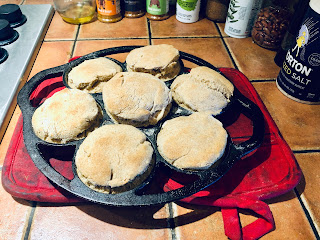I have not forgotten that I promised to develop a more authentic recipe for Beorn's Honey Cakes. To that end, I am experimenting with a set of medieval recipes for similar items. The first one I decided to bake was Ætena Hlaf, "hlaf" being an obvious Anglo-Saxon/Norse cognate for "loaf" (like "hval" for "whale"). “Ætena” is less obvious: the cognate is ‘eating.’
I adapted a recipe from Mary Savelli's cookbook. She is a scholar of Anglo-Saxon and Romano-British history from Ohio (there's you're "Thinking about Rome" for today). Her cookbook is called "A Taste of Anglo-Saxon England," and it's exactly as advertised: its purpose is to provide a taste of what their cuisine was like, rather than fully authentic recipes. For example, in her version of this recipe she mixes whole wheat flour with white flour almost evenly, uses vegetable shortening as the oil, and uses rolled oats for the oats. In her mead recipe, she steeps it with black tea to give it a flavor moderns might find more interesting than the simple flavor of straight mead (honey and water, the sugar of which is digested by the yeast and so absent from the final flavor). This is a perfectly defensible thing to do, and I do not mean it as a criticism: what's the point of making food people won't like? There is also an irony in my quest for a 'more authentic' recipe for a fantasy world than the ones she offers for a historical one; what she's doing is if anything more defensible than what I am.
Still, I wanted to make something that would taste like it came from a kitchen in Beorn's corner of Middle Earth. Now the Hobbits have access to some things that are more 19th-century than otherwise, which seemed rustic to Tolkien but were never intended (especially in The Hobbit) to be medieval. The Elven King has a fully-developed trade network for foodstuffs. Beorn, though, lives by himself in a vale near Mirkwood, trades with no one, and thus has only what he and his beloved animal companions can produce.
When we get to Beorn's honey cakes, I'll make them with butter because of his refusal to harm the aforementioned beloved companions; for an Anglo-Saxon cake, the obvious substitution was lard. It's an excellent baking ingredient (and you shouldn't eat that fake vegetable shortening anyway). I used one egg from our own animal companion chickens, which I think Beorn would be willing to do as well as he also uses butter and honey, products that do not harm his companions by their collection. I went with a full whole wheat flour recipe (I use King Arthur's brand, but probably any good whole wheat flour will do). I recommend a stone ground oat: Bob's Red Mill makes a good Scottish Oatmeal that will do. If you want whole oats, though, you could use a steel cut Irish version.
The final product is supposed to be a 'honey cake,' so it has to be made with honey. There is a quarter cup of honey in the recipe, so it has to be baked at a relatively low temperature. She recommends 375; I went with 400, which is about as high as you can afford with honey to avoid burning it, but the higher temperature gives more 'pop' before the loaves set. There was a notable honey flavor in the finished loaf, like a strong honey-wheat bread. We might want something more like a cake for the final product, although the ‘seed cakes’ aren’t sweet and medieval food was less so than modern American cakes tend to be.
I won't give the whole recipe because it's copywritten, but with those substitutions you can make what I did this morning if you want to play along at home. She gives hers as baked in a loaf pan or as a round on a baking stone (the latter more authentic); I used an Æbleskiver iron to produce small cakes of the sort I will finally wish to produce. Alternatively, though, one could simply divide the dough into about seven parts and make rounds, baking those on a baking stone (or in a wood-fired oven, if you have one; I may build one this fall as a project).


5 comments:
Sounds pretty good……. However I’m partial to lembas bread myself.
https://insanelygoodrecipes.com/lembas-bread-from-lord-of-the-rings/
Greg
Nice.
Thank you Greg. I will give those a try.
@ Grim - I think you have made your compromises and adaptations reasonably. Now let's see how they taste!
I don't know if anyone else is 'playing at home,' but I found them to be a very plausible medieval rustic bread. They're strongly nutty from the whole wheat, with that honey-wheat flavor I mentioned. In terms of texture, though, they remind me of nothing so much as cornbread muffins -- because of the 100% stone-ground whole grains, I imagine, giving them a similar roughness.
You might say they taste like wheat versions of Deep South Southern cornbread muffins, since the honey made them a little sweet the way they like it in the Deep South around Savannah and whatnot. Good breakfast/brunch bread, but definitely not quite right for a honeycake.
Post a Comment